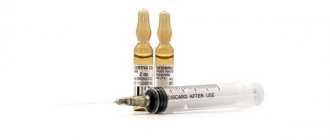The name “Hemothorax” refers to the accumulation of blood in the pleural cavity - the result of internal bleeding. Leads to compression of one of the lungs and displacement of the mediastinal organs to the opposite side.
According to statistics, hemothorax due to chest trauma develops in every fourth patient. It can develop simultaneously with pneumothorax, in which case it is called hemopneumothorax. In any case, the accumulation of blood in the pleural cavity is an acute condition that is dangerous to the health and life of the patient and requires emergency medical care.
What is the danger of not treating hemothorax in a timely manner? Compression of the lung can lead to the development of acute respiratory failure in the patient. And if the internal bleeding is severe enough, it can cause hemorrhagic shock. And within two to three hours from the start of bleeding into the pleural cavity, inflammation develops in it - the so-called hemopleuritis.
1.General information
Hemothorax in medicine is an emergency condition caused by massive hemorrhage into the pleural cavity (the pleura is a closed two-lobed serous membrane of the lungs; the pleural cavity is a narrow space between the internal, visceral, covering the lung, and the external, parietal lobes of the pleura, adjacent to the chest).
Hemothorax is considered the second (after pneumothorax) complication of thoracic injury. Estimates of the frequency of occurrence vary; According to current data, hemothorax is accompanied by 25% to 37% of isolated blunt thoracotraumas, and about 2/3 of all cases of registered polytrauma involving the chest.
A must read! Help with treatment and hospitalization!
Clinical picture
- difficult breathing;
- dull pain that intensifies when taking a deep breath or moving;
- decrease in blood pressure levels;
- arrhythmia, increased heart rate;
- deterioration of general health (dizziness, migraine attacks, in severe cases – fainting);
- copious discharge of sputum mixed with blood;
- sharp chest pain that occurs when you touch the affected area;
- mobility of the ribs (in case of traumatic injury to the chest);
- the formation of numerous local hematomas;
- signs of intoxication of the body (occur if the pathology is complicated by the addition of an infection);
- pale skin;
- hyperhidrosis;
- hypothermia.
2. Reasons
The most common cause is mechanical trauma to the chest (in the broadest sense and spectrum) with disruption of the integrity of large blood vessels.
Two other statistically significant etiopathogenetic factors are background primary diseases (mainly oncological, cardiovascular and infectious, less often hematological) and iatrogenic complications during thoracic surgery.
Visit our Thoracic Surgery page
Diagnosis and treatment of hemothorax
Before prescribing therapeutic measures, the pulmonologist must make a diagnosis. To do this, the patient is interviewed and examined, then he is sent for an instrumental examination. These are radiography, ultrasound of the chest, CT, MRI, endoscopy. Laboratory tests are also required: analysis of sputum, blood contained in the pleural cavity.
After the diagnosis has been made, the doctor prescribes treatment. It can be conservative or surgical. Drug treatment is prescribed for initial or moderate severity of the disease. Therapy includes:
- cardiovascular drugs;
- immunomodulators;
- proteolytic agents.
Treatment of severe hemothorax is more complex. The patient is sent to the surgical department, where he undergoes surgery. During this procedure, the pleural cavity is drained and cleansed of accumulated blood. This is a minimally invasive treatment method. If there is significant damage to the chest with an abundance of wounds, it is opened and the affected areas are sutured. After the operation, stitches are placed and covered with an antiseptic bandage. The patient is also prescribed:
- oxygen therapy;
- intravenous administration of a solution of ascorbic acid and glucose;
- cervical novocaine blockade to relieve severe attacks of pain.
The pathology is dangerous for humans; treatment cannot be delayed. You need to visit a medical facility as soon as possible. The medical department employs highly qualified doctors. The clinic is equipped with modern equipment. This allows you to quickly and accurately make a diagnosis and prescribe treatment.
3. Symptoms and diagnosis
There are many classifications of hemothorax, based on various criteria and allowing to take into account the variety of possible manifestations. The severity of symptoms depends on the volume of hemorrhage, the nature of the causes and the presence of associated injuries.
In general, there is pain that increases with coughing, shortness of breath, hyperhidrosis, dizziness and tinnitus, cyanotic pallor, tachycardia, decreased blood pressure, and, less commonly, hemoptysis. In general, the symptoms are not very specific, often moderate or mild, and sometimes practically absent.
However, in severe cases, a drop in blood pressure can result in hypotonic collapse or hypovolemic shock, and a lack of cellular oxygenation can result in fatal systemic hypoxia. Acute cardiac and respiratory failure, a sharp reduction in circulating blood volume with massive blood loss, the likelihood of pulmonary hemorrhage - together, all this makes hemothorax a particularly dangerous condition with unpredictable dynamics, which requires assistance according to an emergency protocol.
The diagnosis is established on the basis of available anamnestic information, clinical manifestations, results of physical, laboratory and instrumental (if the patient’s condition allows and there is at least a minimum amount of time) examination. The standard of express diagnostics in this case includes plain radiography, CT, ultrasound, pleural puncture, diagnostic thoracoscopy and clinical blood test in cito mode (Latin for “urgent”).
About our clinic Chistye Prudy metro station Medintercom page!
Hemothorax
Hemothorax is one of the diseases caused by complications of open or closed chest injury. This condition is extremely dangerous and requires immediate medical attention.
What is Hemothorax
Hemothorax is a pathology expressed by the accumulation of blood in the pleural cavity. As a rule, the cause of hemothorax is rupture of blood vessels in the lung or chest tissue. In this case, the volume of hemorrhage can reach two or more liters. With extensive disease, there is a violation of the integrity of the intercostal arteries, sometimes the aorta or other large vessels of the chest.
Important! Extensive hemothorax is accompanied by large blood loss, gradually increasing compression of the lung and the development of respiratory failure.
Kinds
Depending on the causes of hemothorax, it is classified as follows:
- Traumatic - caused by internal damage to the sternum due to a penetrating wound, rib fracture or severe bruise. This category of injury is characterized by damage to the blood vessels in the space between two ribs, resulting in blood leaking into the pleura.
- Pathological - occurs with aortic aneurysm, tuberculosis, pulmonary abscess, pleural or lung cancer.
- Iatrogenic – occurs against the background of complications caused by the consequences of surgical intervention in the pleura.
Depending on the duration of bleeding, hemothorax can be:
- stable;
- growing.
Depending on the volume of blood loss, several types of this pathology are distinguished:
- small – up to 500 ml;
- medium – up to 1 liter (the blood level reaches the lower edge of the 4th rib);
- subtotal – up to 2 l (blood accumulation is fixed at the level of the second rib);
- total – over 2 liters (blood completely fills the lung).
Causes
In most cases, the occurrence of hemothorax is caused by an injury: the accumulation of blood in the pleural cavity in 60% of cases is caused by penetrating wounds of the chest, in 8% by non-penetrating injuries.
The main causes of hemothorax:
- tissue damage due to rib fractures;
- gunshot and knife wounds;
- blunt wounds resulting from bruises and leading to rupture of blood vessels;
- rupture of aortic aneurysm;
- pulmonary tuberculosis;
- malignant processes occurring in the lungs;
- thoracentesis;
- lung abscess;
- complications after surgery;
- dysfunction of the coagulation system;
- drainage of the pleural cavity;
- incorrectly performed central venous catheterization.
Important! Blood entering the pleural cavity compresses the lung, which leads to respiratory dysfunction.
Symptoms and signs
Small hemothorax is accompanied by cough, respiratory discomfort and slight shortness of breath. These symptoms do not affect the patient's activity in any way.
Average hemothorax is characterized by a more pronounced clinical picture:
- condition of moderate severity;
- intense cough;
- chest congestion;
- severe shortness of breath, increasing with physical exertion.
The symptoms of subtotal and total hemothorax are similar to each other, but at the same time they differ in severity:
- cyanotic staining of mucous membranes and skin;
- hemodynamic disorders and respiratory failure, causing an extremely serious condition;
- shortness of breath caused by even slight physical exertion;
- severe hypotension;
- dizziness;
- feelings of weakness;
- frequent thready pulse;
- coughing;
- chest pain;
- the occurrence of suffocation in a lying position.
Which doctor treats
A pulmonologist treats hemothorax.
Diagnostic methods
Basic diagnostic tests:
- examination of the patient for the presence of injury, wound;
- X-ray;
- MRI or (if necessary);
- puncture of the pleural cavity to detect suppuration (Petrov’s test);
- Rouvilois-Grégoire test.
By registering at the Health Clinic on Kurskaya, the patient will undergo the necessary diagnostics: MRI, CT, ultrasound, after which he will be immediately referred to a doctor to develop an effective treatment program.
Treatment methods
Hemothorax therapy includes several measures:
- treatment of chest wounds;
- pain relief;
- suturing;
- removal of blood from the pleural cavity by drainage;
- replenishment of lost blood volume;
- antibacterial and antishock therapy.
During the treatment process, the patient is prescribed analgesics, hemostatic and anti-inflammatory drugs, antiseptics, antibiotics and proteolytic enzymes.
Important! Depending on the severity of the pathology, surgical interventions are performed.
results
The prognosis of the disease directly depends on the nature of the injury and how timely treatment was started. Timely prescribed therapy allows for complete recovery in most patients. Lack of medical care or its untimely provision causes serious complications. In advanced cases, death occurs.
Rehabilitation and lifestyle restoration
During the rehabilitation period, the patient needs the following:
- regular examination by a doctor;
- proper nutrition;
- maintaining a healthy lifestyle;
- systematic swimming and breathing exercises;
- carrying out activities aimed at preventing cancer, aneurysm and tuberculosis.
Lifestyle with Hemothorax
People with hemothorax should avoid situations that could cause chest injury. The appearance of the first signs of bleeding in the pleural cavity requires immediate consultation with a doctor.
| Name of service | Price in rubles | Price until 14.01. |
| CT scan of the chest in the morning and evening hours. Promotion | 4 990 | 2 900 |
| CT scan of the chest | 4 990 | 2 790 |
| CT scan of the thoracic spine | 4 990 | 2 890 |
| X-ray of the sternum | 2250 | |
| X-ray of the thoracic spine with functional tests (4 images) | 4190 | |
| X-ray of the thoracic spine (2 projections) | 2560 | |
| X-ray of the chest organs (1 projection) | 1300 | |
| Plain radiography of the lungs 1 projection | 1300 | |
| MRI of the thoracic spine | 4 650 | 3 000 |
If you do not find a service in the price list, please call us and we will provide you with the necessary information.
Our doctors will help you:
General practitioner, immunologist
Zhemchugov Vladislav Evgenievich
4.Treatment
The patient is unconditionally hospitalized in all cases of suspected hemothorax. First-line measures include stopping bleeding, draining the pleural cavity, preventing thrombus formation and lysis of already formed blood clots, blood replacement transfusions according to indications, eradication of infectious pathogens, restoration of respiratory function, cardiac activity and hemodynamics in full.
Sometimes, with the so-called small hemothorax, these problems are solved conservatively; sometimes it is enough to use a high-tech minimally invasive intervention, but in some cases the only choice is thoracic surgery. The nature and scope of the operation is determined (often already on the table) by the causes of hemothorax, the current clinical situation, the patient’s condition and other individual characteristics of the case.







